Tips From Sticks-In-The-Mud Woodshop
by Jim Randolph
Long Beach, Mississippi
Click on any picture to see a larger version.
Welcome to "Tips From Sticks-In-The-Mud Woodshop." I am a hobbyist, not a professional, someone who loves woodworking, just like you do. I have found some better ways to accomplish tasks in the workshop and look forward to sharing those with you each month, as well as hearing your problem-solving ideas.
Tip #1
I'm spooky. No, not in a big-guy, intimidating way, rather, I mean I startle easily. And that can be a dangerous personality trait in the workshop. When I taught microwave communications electronics in the Air Force, one of the first safety lessons we learned was that the big voltage wouldn't get you killed outright. You will always be careful around that. Instead, it's when you let your guard down around small voltages and something gave you a tingle or a spark, startled you, you jerked back reflexively, and you accidentally came in contact with high voltage when you reacted. That sort of reaction around a table saw, radial arm saw or router table (the list could go on) could cost you fingers, or worse. I know that if someone comes into the shop while I'm using a piece of potentially dangerous equipment there is a risk that I will be startled and jump or flinch. That risk is compounded if I'm wearing hearing protection. To help combat such injuries I've installed two means of notifying me that someone is approaching. One is a two-part device that the manufacturer intended for it to turn on a lamp in your home if its outdoor unit detected motion outside your home. Mine is hooked up to lights over my table saw and inside the hood of my radial arm saw.
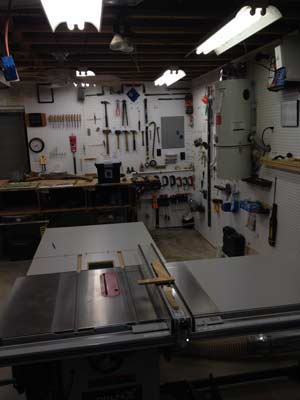
|
|
You can readily see that with the floodlights off (no alert), there is plenty of light to work. Compare to the photo below, in which the alert has been activated and the increased illumination is visible.
|
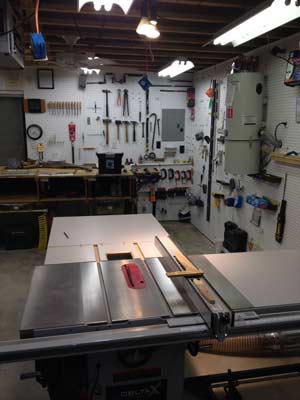
|
|
These two floodlamps illuminate the entire table saw area, so no matter what part of the tool I'm looking at, I will be notified that someone is coming.
|
I have so much light on each tool already that when these two spotlights come on as a visitor warning, the illumination is not shocking.
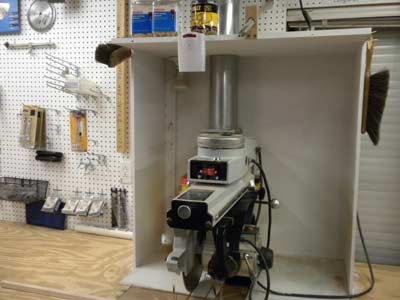
|
|
This light activates in concert with the ones over the table saw, so I am alerted to the presence of someone entering the shop about 30 seconds before they reach my location. The light gets my attention if I'm looking down at the workpiece or up at the saw rail.
|
The detector is located well away from the equipment in the path of the only entrance to the shop. That gives me plenty of notice, about 30 seconds, to either finish the process I'm in, or stop and see who is coming. I also have a $15 motion detector from Harbor Freight that repeatedly makes a "ding-dong" doorbell sound and flashes a red light if my wife comes down the stairs to the shop.
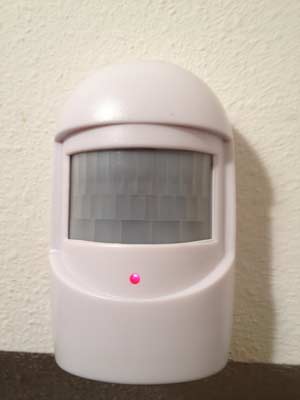
|
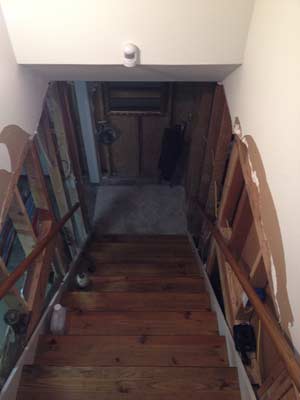
|
This is the sending unit/motion detector on the stairs leading to the shop. It is so sensitive that our cat can set if off if we forget and leave the door to the stairs open.
|
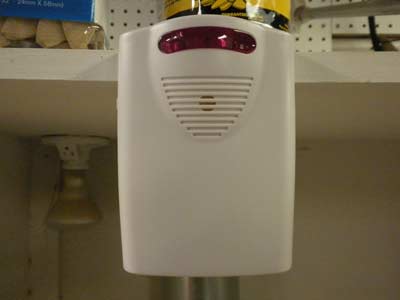
|
|
The Harbor Freight alarm will begin to ding-dong as soon as the stairs door is open, and continues until the person is about 2/3 of the way down the stairs.
|
The tone is amazingly penetrating, even over the din of noisy equipment. Speaking of noisy equipment, I previously wrote about the excellent hearing protection I get from
Bose Noise-Canceling Headphones
. One of their distinct advantages is that sounds such as talking still get through. That means I can hear the "ding-dong" even over the DeWalt planer, easily the loudest piece of equipment in my shop. Bose headphones "know" how to mute the loud noise, yet let the important sounds in.
Tip #2
No Southern-fried Southern boy wants to be called a Yankee, but we share the characteristics of shrewdness and thrift. Thus, each month we include a money-saving tip. It's OK if you call me "cheap."
By now, regular readers have figured out that I'm such a tightwad that I squeak when I walk. When I need a quick something from the shop, like a screwdriver, I don't want to turn on an entire bank of lights. Instead, I have strategically located 10-watt CFLs around the shop to give enough light to navigate.
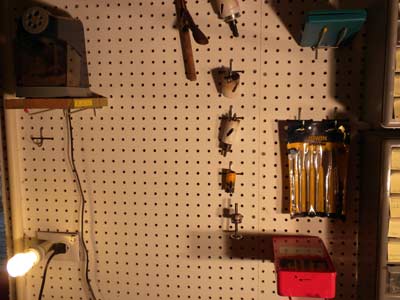
|
|
This little 10-watt bulb, the ferocity of its 6500° Kelvin glow usually partially blocked behind my power miter box stand, still illuminates a 30' x 30' area sufficiently to walk around with no other lights.
|
They will burn continuously for pennies a month. I screw them into plug-in light bulb adapters that fit a standard electrical outlet.
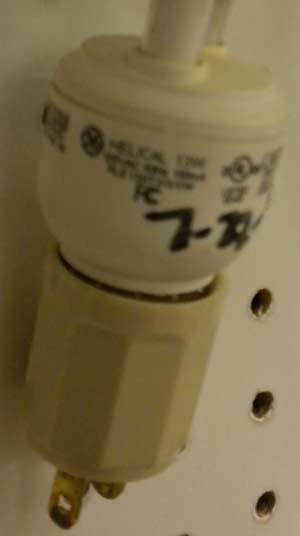
|
|
These little adaptors sell for about $3.00 each. You can screw any size standard-based bulb into it, allowing you to have a light anywhere you have an outlet. I like to put the installation date on light bulbs and batteries to know how long they last. It's easy to remember once you get into the habit.
|
Two or three in the right location can illuminate an amazing amount of area, with enough light to walk around safely. Because their light can be a little harsh (I like the 6500° Kelvin blue light color), I like to unplug them when I'm working. They require a safe place to reside while not in use. A short piece of fishing line tied into a loop secured with several square knots makes a handy lanyard for hanging, but a pegboard hook works well with no other enhancement.
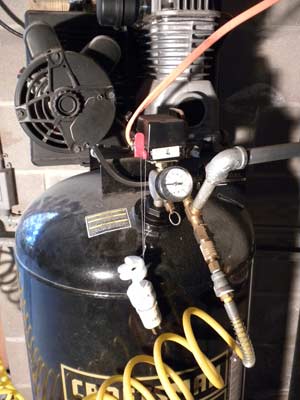
|
|
How did mankind advance before fishing line? It has so many uses! Here, it makes a great hanger for these CFLs when not in use.
|
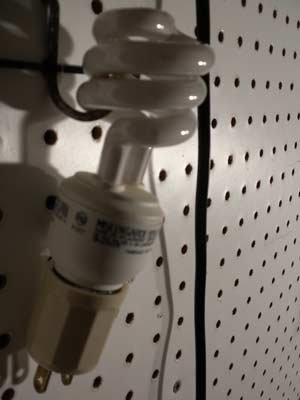
|
|
When pegboard is already near where the bulb is used, a simple U-shaped hook holds the bulb until it's time to plug it back in.
|
Jim Randolph is a veterinarian in Long Beach, Mississippi. His earlier careers as lawn mower, dairy farmer, automobile mechanic, microwave communications electronics instructor and journeyman carpenter all influence his approach to woodworking. His favorite projects are furniture built for his wife, Brenda, and for their children and grandchildren. His and Brenda's home, nicknamed Sticks-In-The-Mud, is built on pilings (sticks) near the wetlands (mud) on a bayou off Jourdan River. His shop is in the lower level of their home. Questions and comments on woodworking may be sent to
DrRandolph@MyPetsDoctor.com
. Questions about pet care should be directed to his blog on pet care,
www.MyPetsDoctor.com
. We regret that, because of high volume, not all inquiries can be answered personally.
Return to
Wood News
front page


